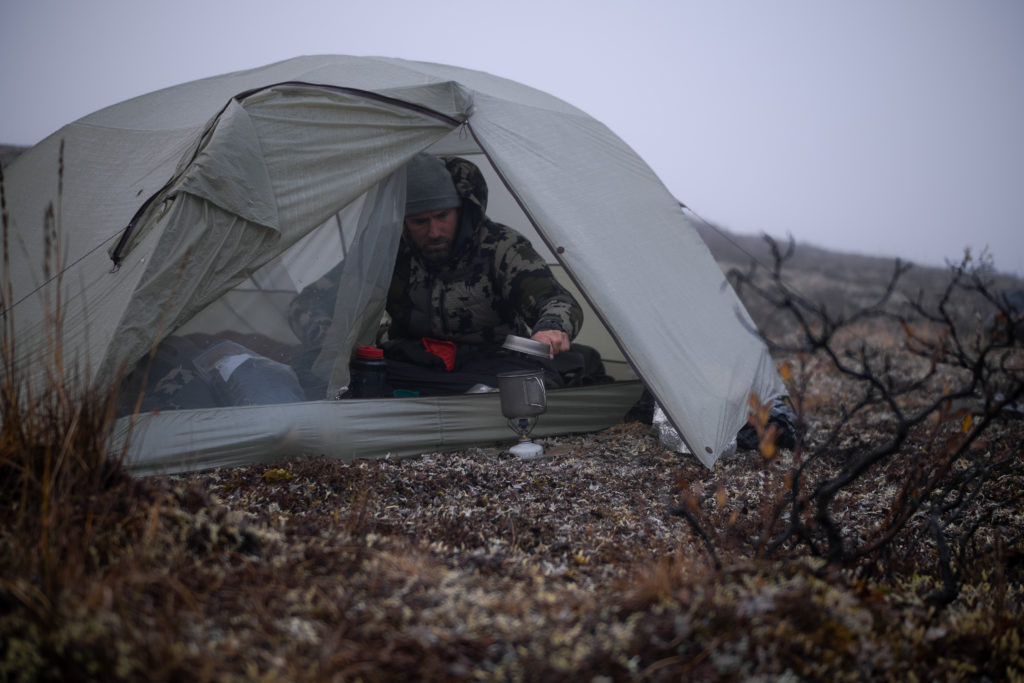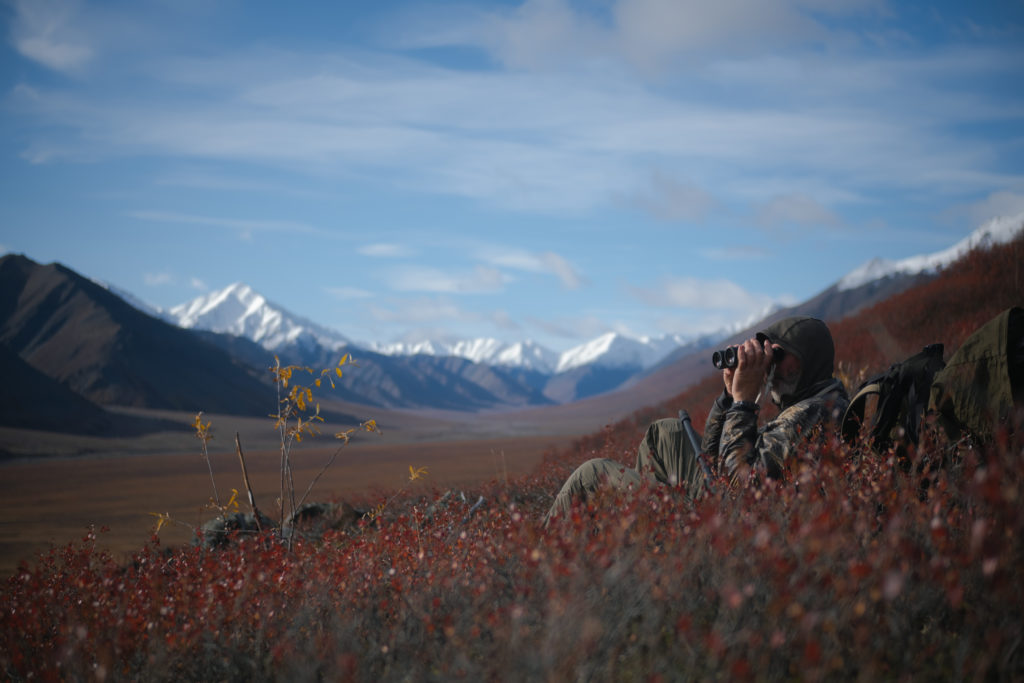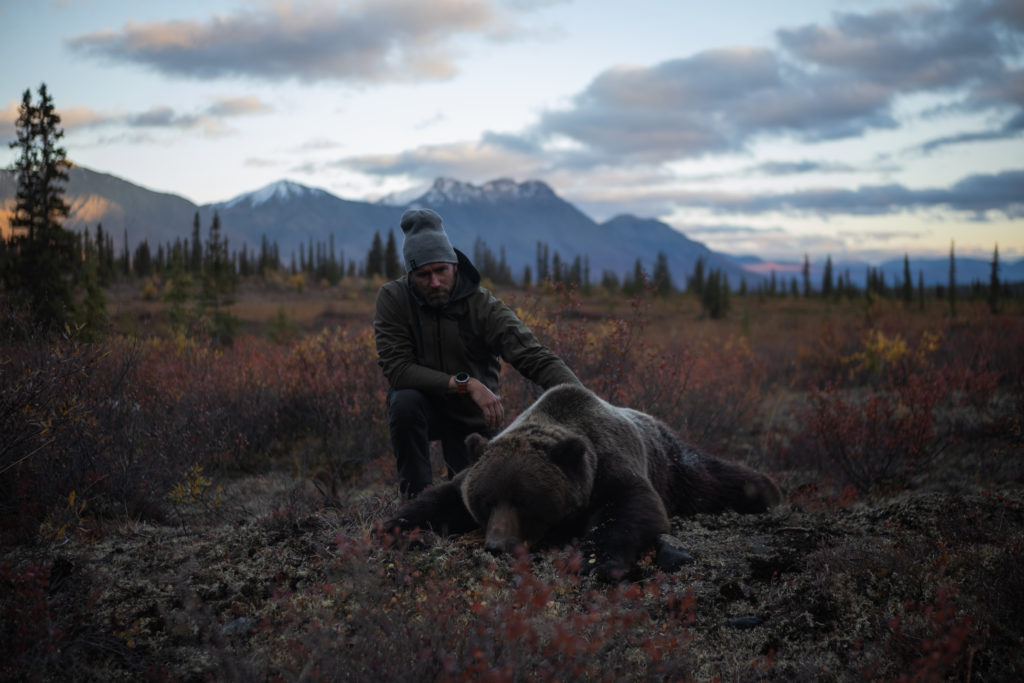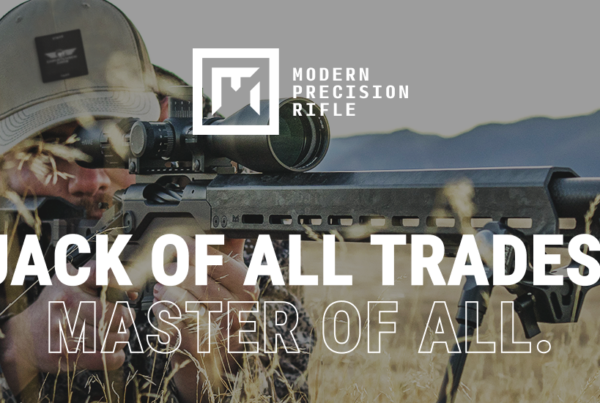Meeting Grizzly
Featured Content
Sep 23, 2020 | Christensen Arms
By Christian Schauf
Could I ever shoot a grizzly bear? Tough call. But even as an avid hunter, outdoorsman and conservationist I didn’t think so – until I did.
Let me back up.
Growing up on a farm in Wisconsin I have always considered hunting a part of life. I fondly remember Thanksgiving morning game drives with my brothers, father and Grandpa, and the excitement of a big, opening-morning whitetail buck loaded in the back of a truck. My interest in those late November tree stands waned years ago. In its place, athletic spot and stalk mountain hunts for bigger game have consumed me.
Two years ago I traveled to British Columbia and fought through bitter cold and ungodly mountain miles to harvest a record book moose. Last year I helped my dad harvest a huge bull elk during archery season in Utah. So this summer, with the freezer empty, another adventurous hunt sounded perfect.
How about an ‘exploratory hunt’ in the Brooks Range of The Arctic Wildlife Refuge in Northern Alaska? With only half a dozen non-resident hunters allowed in the huge, 500,000 acre area – half the size of Rhode Island – this promised to be an epic adventure. So a year ago I didn’t hesitate when I could sign the papers for a two-week trip into this remote wilderness in the far-northern tip of the United States.
I logged in to the Alaska Fish and Game website to buy my license and tags. Moose? Definitely. Caribou? Check. Grizzly? I paused. Unable to envision shooting a bear I moved on, buying one anyway and figuring I’d decide later.
The Brooks Range has held reverence to me, and many others, for years. In a state known as the Final Frontier, the Brooks Range may well be the quintessential representation of one of the world’s last truly wild places. Thousands of miles of majestic, unforgiving wilderness, accessible only under heavy loads and with careful planning.
Photographer Micah Berman and I departed Fairbanks in a stuttering, brown-and-white Helio airplane from Wright’s Air Field on the morning of September 1. My friend Reilly had planned to hunt with me, but a last minute change of plans left an open spot – one too valuable not to fill. Micah happily agreed to the adventure.
We flew past the edge of town, followed the Alaskan Pipeline for 30 minutes, then headed towards our remote camp in the Chandalar River Basin. Rolling green hills gave way to foothills, which gave way to mountains. Nearly an hour in to our flight, we crossed over a ridge line and took in our first true views of the Brooks. Red, yellow, brown and green foliage swirled below jagged mountains. Rivers serpentined through willows and small stands of spruce. We spotted the occasional moose and black bear before circling and touching down on a river basin next to camp. Two small yellow tents and one larger green tent welcomed us to home base.
A white wire fence around the green tent, connected to a small battery, signaled the presence of grizzly bears. I wondered why the other tents – including mine – didn’t get a plot inside the protected perimeter.

Storm clouds were building, so we quickly moved gear inside the tents, and met our guide, Fred Harbison. Standing a lean 6’3” tall, Fred had a mischievous smile and a gait that told me he was going to be hard to keep up with. Born to a CIA agent father, he grew up in Africa, received a biology degree, taught high school and Outward Bound before switching careers to become a paramedic and para-firefighter.
‘My favorite thing? I like to parachute in for sheep hunts and hike out’, he told us. It was not a figure of speech, I later learned. We were in good hands.
With over half a million acres our fingertips, the options and directions were endless for our departure the next morning. But also simple, Fred explained: ‘We can go north or we can go south. I say we go south. That is some awesome country.’
Good enough for me.
I woke to a cool, damp morning and headed to the cook tent to make myself a cup of strong coffee with a few scoops of hot chocolate mix. A large gray wolf silently patrolled the opposite river bank, stopping only to let out a single long, lonely howl. After going over rations which mainly consisted of bricks of cheese, pounds of salami, Snickers, trail mix and Mountain House meals, we gave our packs a final weigh-in; mine was 73 pounds. We departed in southernly direction, planning to return in six days with a caribou in our packs.
We followed the river bed downstream for a few miles, criss-crossing streams, sand bars and river rock before hitting a well-worn game trail going up into the foothills. Footprints, scat and even the occasional spruce covered in grizzly hair – left from a good back scratch – littered the trail to remind us whose home we were traveling through.
Fred carried his rifle in hand. I elected to do the same.
‘Keep your chamber empty, three in the mag and a fourth in your pocket’,’he would say a couple times a day as he patted his front pants pocket. We were traveling safely, but only a second away from action at any point. The backup round lived in the pocket for quick access in case the first three bullets didn’t get the job done.
We moved quietly, hunting as we traveled, and stopped occasionally to shed a layer of clothing, change out our socks or have a quick look through the binoculars. With only a few moose in the far distance, we stayed the course. Curving to the east, we followed a large valley through endless blueberry fields. We climbed steep drainages of soggy tundra, each foot step sinking nearly a foot and sucking the energy from my quads.
Our plan to camp at Low Pass for the night was scrapped once it came into view. Low hanging clouds suggested the pass was drenched, so we cut our hike short at nine miles. Making camp at a lower elevation allowed us to spend the evening looking for animals on the mountain sides.
As we glassed the hillsides, we constantly reviewed our plans and goals. My primary goal, all along, was to fill the freezer. I love moose, but had never had caribou. My preference? ‘Let’s see what we find,’ was my response. I’d hunted enough to know that you can make plans, but in the end you always end up playing the hand mother nature deals.
The contradictions of hunting have inspired countless books, documentaries and podcasts. As a hunter, I understand and respect multiple perspectives on the topic. From my Utah home I’ll watch an elk herd for hours with my camera. I’ll fight to protect their migration paths through my home town. But come September, I won’t hesitate to send an arrow towards a big bull.
Meat that I have personally harvested makes every bite special – to the point of preciousness. My frustration is palpable when someone leaves a half eaten steak at a restaurant. That animal sacrificed its life. The least we can do is honor it by making sure it doesn’t end up in the garbage. I’ve confused more than one restaurant patron, kindly asking whether I might take their meat home if they weren’t going to finish it.
But grizzly? You don’t really eat grizzly. Trichinosis is common in all bears, and it is easily passed to humans. It’s a terrible condition causing nausea, diarrhea, vomiting and more. But such misery aside, the question of flavor must be asked. Depending on what a bear has been eating the taste can go from over-cooked steak – bear meat must be prepared very well-done to kill the trichinosis roundworm – to ‘a combination of dead rotting fish and dog food’ according to Fred. They quite literally are what they eat.
So there I sat on a hillside, the grizzly tag in my pocket, the gun by my side, searching through my binoculars in grizzly country and thinking, ‘why would I shoot a grizzly’?

She has thrived, as have her fellow bears there. According to the U.S. Fish and Wildlife Service in 2018 the Yellowstone bear population had rebounded from a low of only 136 to over 1700 individuals, far exceeding the carrying capacity of the 22,500 square mile Yellowstone area. One immediate effect of this over-population: grizzlies were responsible for killing over 80 cattle and 30 sheep in 2018 alone, forcing the need for bear-proof barns, grain bins and electric fences, causing financial hardships to local ranchers. Yet despite not qualifying as an Endangered Species anymore, they remain protected, thanks to public pressure and a culture in love with the anthropomorphism made popular by the likes of Walt Disney and Hanna Barbera.
Alaska is a different story. There are officially 40,000 grizzlies in the millions of acres that constitute the Brooks Range alone, but experts I’ve spoken with say that the actual number is likely double and approaching 100,000 individuals. Even at official numbers, with less than 400 bears harvested in 2019, that’s less roughly 1% of the population. The responsible guides focus on old male bears, which provides an immense amount of benefit to a population with no natural predator.
Without human involvement the natural cycles of apex predators like bears go something like this. A bear population grows due to the lack of predation and an abundance of food. The population outgrows the environment’s ability to support and sustain it. Disease and starvation create a massive decline in bears. The environment rebuilds and replenishes. Ample food now supports the bear population to grow and the cycle repeats. The length of this cycle is debatable, but 70 years is a good estimate. Which means that for decades bears may be near endangered levels before beginning an upward trend. A few extreme winters or fire seasons could decimate the population.
Enter hunting. Selectively hunting older male bears greatly reduces the impact on the environment, for a mature male grizzly will have up to a 600-mile range. In addition, a mature boar will often kill cubs up to two years of age. This helps them kill off future competition before they become competition, and also puts the sows back into estrus, allowing the male to mate with her and pass along his genetics.
With human involvement, the 70-year cycle becomes much shorter. And the extremes are being mitigated. ’It’s like Prozac,’ Fred said. ‘You just kinda stay right down the middle. No high highs. No low lows.’
The next morning we woke up to a solid rain shower, which would soon reveal to be the theme of the week, adding one more layer of complexity to our mission. Any experienced outdoorsman knows that keeping dry can mean the difference between life and death. We’d dress for the day and fill our packs strategically for the multiple changes of socks, base layer and rain gear dependent on weather and effort. We ate, packed up camp and continued on our journey.
As an avid shed hunter I found myself wanting to pick up every moose and caribou antler we passed, but given our heavy loads there wasn’t room – or the strength in my legs. So we stuck them high in trees, announcing ‘I already found this one’ in the unlikely case someone came wandering through after us. We all grabbed for the occasional handful of blueberries as we pushed up and over what felt like endless drainages, scanning the horizon for big game.
Just past a hilltop we found a family of three musk ox. The largest, a male, was simply huge. Enormous horns bonded together in the middle of his head to form a battle-worthy helmet, or boss. His long coat hung to the ground and swayed as he walked, like the pieces of fabric that sway back and forth at an automatic car wash. With him was his lady friend and a young calf. This was an extremely rare sighting. ‘I think they’re lost. They’re not supposed to be here…’ Fred commented. We sat and watched for 15 minutes as they meandered around the hillside, selectively grazing from the salad bar.
A few hours later we found a flat spot at camp among some small willows on a river’s edge. Once again, we set up camp and headed up on to a hillside to glass the valley through our binoculars. We truly were in the North American Serengeti. A mother grizzly led her two cubs up a rocky drainage behind us. Dall sheep watched from the highest peaks off to the west, while wolves and caribou worked their way across the opposite hillside. One bull caribou looked especially large as he silhouetted against the setting sun, only to dip down the backside of the range never to be seen again. ‘There’s a reason the big ones get big,’ Fred commented to no one in particular.
The next morning came full of anticipation. Confident in our plan we headed up the same hillside the caribou had passed the night before and found a high glassing spot. We spent the day traversing ridge lines and finding different vantage points, even fitting in an hour long power nap under a rocky outcropping during a snow storm. But a few distant herds of caribou and one lone wolf were our only excitement for the day. That said, it was the most beautiful place I’d ever seen. We absorbed the hundreds of miles of untouched wilderness and Micah constantly worked to capture the moments, his camera covered in homemade duct tape and a ziplock bag for weatherproofing.
We headed back to camp along a river in a building rainstorm, getting into our tent around 10 pm, soaking wet. We began making ourselves dinner and drying out as best we could. I shed my outer pants and light jacket and crawled into my sleeping bag, still fairly wet, with a bottle of hot water. As the sleeping bag heated up, I would get out of it and steam would billow off of my legs and shoulders as a massive evaporation cycle took over. Once the steam stopped, I repeated the process. After about a dozen cycles, I had shed most of the moisture and knew that the rest would be gone by morning. I put down as much food as I could stomach and passed out hard.
We woke the next morning to the sound of someone throwing up. Fred had come down with something. With the serious meds back at base camp, we quickly decided to slow hunt back. We started a big fire, spent an hour drying out our gear and headed back.
Hunting this way is 95% hiking and glassing under heavy packs, and 5% action. The next several days were more of the same. My quads screamed and sweat poured off the end of my hat. My watch let me know I’d passed my step goal in the first few hours of each day, closing out with about 30,000 steps. I wished there was an ‘I also carried a 70-pound pack up a mountain through the tundra’ credit to select.
As we approached one deep drainage, we spotted a large female grizzly and her two cubs about 70 yards in front of us. Micah paused to shoot photos and Fred continued forward. Knowing Micah’s only protection was a 9mm, I stopped somewhere in the middle as to not abandon him. Suddenly things got interesting. The bear led her cubs up the hill, directly towards a wildly yelling Fred. Keeping my eyes on the increasingly concerned mother grizzly as she and her cubs stood up on their hind legs to assess Fred, I reached in to my front pocket and put my ‘fourth’ in the chamber. I wanted all the shots I could take if things escalated. I paused at an elevated position on the opposite side of the drainage to wait for Micah, and waited for things to unfold.

In what can be best described as a grizzly’s version of a kung fu fighter cracking their neck left to right and cycling their hands up in a fighting position, this mother decided it was go time. Her hair bristled. She began woofing, sounding almost ape-like. Then she spun a few tight circles before deciding Micah seemed like a solid first fight. As soon as she took two steps towards Micah, Fred put a round of .375 in the dirt in front of her, exploding the ground at her feet. I raised my scope and took my safety off, watching as she froze, then spun around and headed the opposite direction out of the drainage, cubs in tow.
The danger averted, I took a deep breath and laughed to myself. I’ll never forget the sight of the two small cubs chasing mom as fast as they could down the valley and out of sight, their rear legs flailing behind them.
I manipulated the action on my gun, extracted my unspent round and put it back in my front pocket. I looked at Micah and gave him a quick ‘wow’ with my eyebrows. We resumed our journey, thankful for the outcome and excitement.
We traveled for another 6 hours and as the rain moved out and the evening sun arrived, we decided to set up camp on a high rock bluff below a small waterfall Fred had named Wolf Camp. After all of the rain and wind, we had a feeling the animals would start to move.
We took our boots off to dry our feet, boiled hot water for coffee, and set up make-shift seats for a long glassing session looking for a sizeable bull moose or caribou.
‘I’ve got a bear,’ Micah whispered, focused on something in his binoculars. About a half mile out, silhouetted on a grassy knoll, was a large male grizzly. We all turned our attention towards the knoll. ‘He’s a shooter,’ Fred said. ‘Let’s slowly get our boots on and get a closer look. The wind is perfect.’
We suited up, pounded our precious coffee and crept in the direction of the bear.
Was this going to happen? We dipped in and out of stands of spruce, spotting the animal, losing him and spotting him again as he meandered through the forest. ‘He’s a big bear. He’s got that Sumo walk,’ Fred said.
We were about 250 yards out when he turned started to walk our way. I found a shooting lane and took my safety off. He came into focus and winded us, realizing we were there for the first time as he looked directly in our direction.
Time stopped. My heart raced. My brain processed in slow motion. Let him go: he now knows of our presence and is just a few hundred yards from our tents, so he’d either leave the area or come in for a closer look. Pull the trigger: a perfect shot ends this, but anything less creates an extremely dangerous situation with an injured predator in his own woods.
I heard Fred whisper, ‘Clear to shoot.’ The words barely left his mouth as the bullet flew down the carbon fiber barrel of my 300 win mag Christensen Arms Ridgeline. Immediately I reloaded as the bear bit behind his front leg. He quickly spun and lunged forward into a dense section of spruce trees. Unable to locate him in my scope, I paused and realized that my ears were ringing. All was now silent. I looked to Fred to follow his gaze.
‘Did he run? It felt like a good shot.’
‘No, no, the shot was perfect. Just listen.’
Very slowly we started to step to the side to see if we could see him. Hear him. Anything. A few seconds later we rounded a large tree and found him, peacefully resting some 30 yards from where he was standing when I pulled the trigger.
Still careful, we approached and confirmed he was dead. Only then did we take the bullets out of our guns, and breathed.
The moment you touch your animal for the first time is strange and deep. Moments before, it was an unpredictable and serious threat. And now, something different. Emotions come in waves. Excitement. Sadness. Thankfulness. Relief. Regret. A Native-American friend once told me that anytime you harvest an animal, the animal has agreed to let you take them. I like to think there’s truth to that.
This magnificent bear spent his life as the king of the valley. Now his time has come to an end. And what a good-looking king he was. I’ve seen dogs leave a groomer dirtier than this old warrior. His coat smelled of lavender and spruce. Each hair stood back up with pride as my hand passed over it. His teeth were perfectly white. We rolled him in to a peaceful position, closed his eyes and decided to come back in the morning to dutifully pack him up.
The bear, now ‘my bear’, a saying I’m never overly comfortable with – was nine foot tall standing up, likely 12 to 15 years old (a tooth was extracted by the Fish and Game Department after our hunt, which will provide valuable information on him and the rest of the population) and in excellent health. He was an example of conservation at work. My bullet had pierced both lungs and his heart, meaning his end was as quick and painless as could be. As perfect of an ending as one can hope.
I returned to camp the next day with a 90-pound pack, insisting I and I alone carry him back. Still focused on filling the freezer, we had quickly taken care of the bear and repacked to head north. With us were now a couple pounds of grizzly meat. I didn’t care if it tasted like a New York City sewer, I was going to honor him the right way.
We fought for four days through wind, snow, sun and rain, but harvestable caribou and moose evaded us. Our hunt eventually came to an end as the sun set on our last day. We reflected together in the main tent until late, then stepped outside to a full display by the Northern Lights. A proper Alaskan send-off.
The next morning I loaded my gear on to the 1958 Beaver airplane, bounced down the riverbed, pulled up and arched over the valley I’d called home for two weeks. I tried to absorb the last few views before returning to civilization.
I thought of the dozen cubs we saw and how their odds of survival had instantly improved. I thought about my bear’s life, and what living for almost two decades in this valley must have been like. And I thought how amazing it would be to bring my own son someday, knowing the opportunity for him to experience these same emotions would exist because of the efforts of scientists, hunters and conservationists. Hunting provides $1.6 billion a year towards conservation efforts. Those dollars go towards protecting healthy animal populations and habitats, ensuring these opportunities don’t end with our generation.
I’m thankful beyond words for the experience and the opportunity to face tough questions. I’m also anxious to share my story and continue deep conversations about nature, humans, and our part in it all.
Would I shoot a grizzly again? I’m still not sure. But I do not for one moment regret my encounter with the king of that Brooks Range valley.





